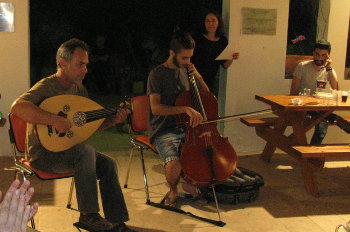Home > Oasis of Peace > How we celebrated Ramadan
How we celebrated Ramadan
Friday 17 July 2015

Many of the Muslim families in the village, in accordance with tradition, fast during the month of Ramadan, and break the daily fast with the Iftar meal. In a custom established by Abdessalam Najjar (Allah irrahmo), we have our own tradition in the village of holding a joint weekly potluck meal and get-together for the village residents. This is one of the few times a year when families get together in this way.
This year, the municipal committee, led by Adnan Manaa, together with Raida Hatib, Dafna Karta-Schwartz and others, helped organize the weekly events. Since one of the themes of Ramadan is to foster peace and togetherness between neighbors and within the community, we decided to use this theme in order to enhance the relations between our community members. In solidarity with the fasters, Jewish and Christian members naturally took part in the events too. The holiday also gave us the opportunity (on the second meeting) to welcome three new babies that had been born during the year and congratulate their families: Adam Boulos, born to Miea and Sliman; Rayan Abu Anza, born to Nour and Morad; and Muhammad, born to Shireen and Mustafa.
Every Tuesday there was a special event. On the first, Dr. Abed Hijazi spoke about the health benefits of fasting, and this was followed by music and songs. As with subsequent meetings, there was a short prayer for those who wished to pray, and a delicious dishes brought by the participants, both Jews and Palestinians. The first three meetings took place in the PSCC.
On the second meeting, we decided to bring a film. As suggested by Marwa Jabarah Tibi, we watched the film, “The Bride of Jerusalem,” and this was followed by discussion. The film captures the complexities of life for the Arab residents of Jerusalem’s old city. The evening ended with music and songs.
On the third meeting, Abed Hijazi spoke about the ways in which the Quranic story of Ibrahim matches the Judeo-Christian versions of the story. He was able to show the strong resemblances between the two stories, as well as to mention the differences. Village member and actor Imad Jabarin told a traditional story for the audience. The story was told in beautiful Hebrew, with many a dramatic flourish. Ibrahim Khatib, together with a young musician, then played traditional songs on the oud, and the audience joined in too. Some guests, including a well-known judge, joined us for the evening.
The fourth and last meeting took place at the swimming pool. Since this was the last event before the Eid al-Fitr holiday, we made sure that the event was even more colorful and festive than the earlier ones. Following a delicious meal, the participants shared reminiscences from their childhood and adolescence – including their memories of Ramadan, either as a participant or as on onlooker. Adnan, for example told how, as a child growing up in the village of Majdal Krum, he remembers how the young people of the village would stand near the mosque to wait for the muezzin to signal, with a red flag, that the month of fasting was officially over. Since the village at the time still had no electricity, this was the only way to know. The young people would then eat some sweets and rush home to tell their families that it was permissible to eat. Adnan also told how items like certain fruits would hardly be seen in the village during other months. It was also the only time that parents could afford to buy new clothes for their children. In Majdal Krum, this involved a visit to nearby Acre. However, leaving the village at this, or any other time, entailed going to the local police station in order to obtain an official permit. Military rule over Arab towns extended into the mid-1960s.
As with the previous meetings, the evening ended with music and song. There was also an open discussion on the series of gatherings and on community life. Everyone thought the celebration had been a success. It was well-attended by both Palestinian and Jewish members, and had accomplished its purpose of bringing people together. In fact, one of the conclusions drawn is that we must create other opportunities, at least every couple of months, for members of the village to gather informally in this way.